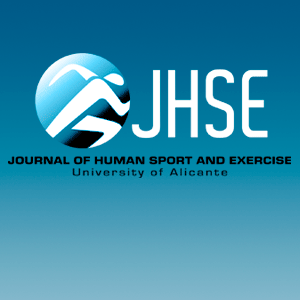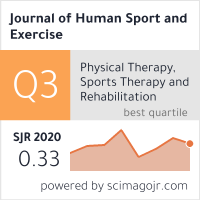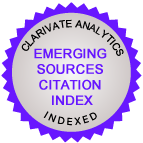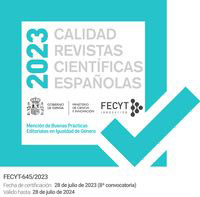Comparison of electromyogram reaction time at the onset of motion in badminton players at different competitive levels
DOI:
https://doi.org/10.14198/jhse.2022.174.12Keywords:
Championship, Sports performance, ShuttlecockAbstract
In this study, we evaluated the electromyogram reaction time of femoral muscles at the onset of motion in college badminton players at different competitive levels, with the aim of clarifying the characteristics of the motor reaction processing in response to stimulation. The participants were seven male players from the team that won second place in the All Japan College Badminton Championship (high-performance group) and college badminton players with no experience in participating in national championship games (low-performance group). In both the 1-direction and 2-direction tasks, the action time was shorter, and the pre-motor time of femoral muscle activity was significantly shorter in the high-performance than in the low-performance group. In both tasks, significant differences were observed in the rate of increase in absolute EMG amplitude of the swing-out and push-out legs, and the values were higher in the high-performance than in the low-performance group. Results indicate that high-performance badminton players are able to move quickly by synchronizing the motor units of the rectus femoris muscle at the onset of motion and perform actions by exerting large joint torques.
Funding
Research Grant of the Health Science UniversityDownloads
References
Abernethy, B. (1990). Expertise, visual search, and information pick-up in squash. Perception, 19(1), 63-77. https://doi.org/10.1068/p190063
Abernethy, B., & Zawi, K. (2007). Pickup of essential kinematics underpins expert perception of movement patterns. J Mot Behav, 39(5), 353-367. https://doi.org/10.3200/JMBR.39.5.353-368
Ando. S., Kida. N., & Oda. S. (2001). Central and peripheral visual reaction time of soccer players and nonathletes. Percept Mot Skills, 92(3), 786-794. https://doi.org/10.2466/pms.2001.92.3.786
Farrow, D., & Abernethy, B. (2002). Can anticipatory skills be learned through implicit video-based perceptual training? J Sports Sci, 20(6), 471-485. https://doi.org/10.1080/02640410252925143
Halliday. D.M., Conway, B.A., Farmer. S.F., & Rosenberg. J.R. (1999). Load-independent contributions from motor-unit synchronization to human physiological tremor. J Neurophysiol, 82(2), 664-675. https://doi.org/10.1152/jn.1999.82.2.664
Hülsdünker, T., Strüder, H.K., & Mierau, A. (2016). Neural correlates of expert visuomotor performance in badminton players. Med Sci Sports Exerc, 48(11), 2125-2134. https://doi.org/10.1249/MSS.0000000000001010
Jackson, R.C., & Mogan, P. (2007). Advance visual information, awareness, and anticipation skill. J Mot Behav, 39(5), 341-351. https://doi.org/10.3200/JMBR.39.5.341-352
Jin, H., Xu, G., Zhang, J.X., Gao, H., Ye, Z., Wang, P., Lin, H., Mo, L., & Lin, C.D. (2011). Event-related potential effects of superior action anticipation in professional badminton players. Neurosci Lett, 492, 139-144. https://doi.org/10.1016/j.neulet.2011.01.074
Kamimura. T., Yoshioka. K., Ito. S., & Kusakabe. T. (2009). Increased rate of force development of elbow flexors by antagonist conditioning contraction. Human Movement Science, 28(4), 407-414. https://doi.org/10.1016/j.humov.2009.02.005
Kanda, Y. (2013). Investigation of the freely available easy-to-use software 'EZR' for medical statistics. Bone Marrow Transplantation, 48(3), 452-458. https://doi.org/10.1038/bmt.2012.244
Kellman, P.J., & Garrigan, P. (2009). Perceptual learning and human expertise. Phys Life Rev, 6(2), 53-84. https://doi.org/10.1016/j.plrev.2008.12.001
Liu. T., Shao. M., Yin. D., Li. Y., Yang. N., Yin. R., Leng. Y., Jin. H., & Hong. H. (2017). The effect of badminton training on the ability of same-domain action anticipation for adult novices: Evidence from behavior and ERPs. Neurosci Lett, 660: 6-11. https://doi.org/10.1016/j.neulet.2017.08.038
Masu, Y., & Muramatsu, K. (2015). Soleus H-reflex modulation during receive stance in badminton players in the receive stance. J Phys Ther Sci, 27(1), 123-125. https://doi.org/10.1589/jpts.27.123
Masu, Y., & Nagai, M. (2016). Characteristics of lower limb muscle activity during upper limb elevation in badminton players. J Phys Ther Sci, 28(9), 2510-2514. https://doi.org/10.1589/jpts.28.2510
Masu, Y., Udaka, R., & Muramatsu, K. (2019). Alteration of F waves by motor imagery with and without hitting in badminton. Int J Phys Ther Rehab, 5, 158. https://doi.org/10.15344/2455-7498/2019/158
Nakazawa, K., Miyoshi, T., Sekiguchi, H., Nozaki, D., Akai, M., & Yano, H. (2004). Effects of loading and unloading of lower limb joints on the soleus H-reflex in standing humans. Clin Neurophysiol, 115(6), 1296-1304. https://doi.org/10.1016/j.clinph.2004.01.016
Nielsen, J., Crone, C., & Hultborn, H. (1993). H-reflexes are smaller in dancers from the Royal Danish Ballet than in well-trained athletes. Eur J Appl Physiol Occup Physiol, 66(2), 116-121. https://doi.org/10.1007 / BF01427051
Nishihira. Y., Araki. H., & Ishihara. A. (1991). Attenuation of somatosensory evoked potentials immediately following rapid reaction movement. Electromyogr Clin Neurophysiol, 31(1), 15-20.
Phadke, C.P., Klimstra, M., Zehr, E.P., Thompson, F.J., & Behrman, A. L. (2010). Soleus H-reflex modulation during stance phase of walking with altered arm swing patterns. Motor Control, 14(1), 116-125. https://doi.org/10.1123/mcj.14.1.116
Picton. T. W. (1992). The P300 wave of the human event-related potential. J Clin Neurophysiol, 9(4), 456-479. https://doi.org/10.1097/00004691-199210000-00002
Stroeve. S. (1999). Impedance characteristics of a neuromusculoskeletal model of the human arm I. Posture control. Biol Cybern, 81(5-6), 475-494. https://doi.org/10.1007/s004220050577
Downloads
Statistics
Published
How to Cite
Issue
Section
License
Copyright (c) 2018 Journal of Human Sport and Exercise

This work is licensed under a Creative Commons Attribution-NonCommercial-NoDerivatives 4.0 International License.
Each author warrants that his or her submission to the Work is original and that he or she has full power to enter into this agreement. Neither this Work nor a similar work has been published elsewhere in any language nor shall be submitted for publication elsewhere while under consideration by JHSE. Each author also accepts that the JHSE will not be held legally responsible for any claims of compensation.
Authors wishing to include figures or text passages that have already been published elsewhere are required to obtain permission from the copyright holder(s) and to include evidence that such permission has been granted when submitting their papers. Any material received without such evidence will be assumed to originate from the authors.
Please include at the end of the acknowledgements a declaration that the experiments comply with the current laws of the country in which they were performed. The editors reserve the right to reject manuscripts that do not comply with the abovementioned requirements. The author(s) will be held responsible for false statements or failure to fulfill the above-mentioned requirements.
This title is licensed under a Creative Commons Attribution-NonCommercial-NoDerivatives 4.0 International license (CC BY-NC-ND 4.0).
You are free to share, copy and redistribute the material in any medium or format. The licensor cannot revoke these freedoms as long as you follow the license terms under the following terms:
Attribution — You must give appropriate credit, provide a link to the license, and indicate if changes were made. You may do so in any reasonable manner, but not in any way that suggests the licensor endorses you or your use.
NonCommercial — You may not use the material for commercial purposes.
NoDerivatives — If you remix, transform, or build upon the material, you may not distribute the modified material.
No additional restrictions — You may not apply legal terms or technological measures that legally restrict others from doing anything the license permits.
Notices:
You do not have to comply with the license for elements of the material in the public domain or where your use is permitted by an applicable exception or limitation.
No warranties are given. The license may not give you all of the permissions necessary for your intended use. For example, other rights such as publicity, privacy, or moral rights may limit how you use the material.
Transfer of Copyright
In consideration of JHSE’s publication of the Work, the authors hereby transfer, assign, and otherwise convey all copyright ownership worldwide, in all languages, and in all forms of media now or hereafter known, including electronic media such as CD-ROM, Internet, and Intranet, to JHSE. If JHSE should decide for any reason not to publish an author’s submission to the Work, JHSE shall give prompt notice of its decision to the corresponding author, this agreement shall terminate, and neither the author nor JHSE shall be under any further liability or obligation.
Each author certifies that he or she has no commercial associations (e.g., consultancies, stock ownership, equity interest, patent/licensing arrangements, etc.) that might pose a conflict of interest in connection with the submitted article, except as disclosed on a separate attachment. All funding sources supporting the Work and all institutional or corporate affiliations of the authors are acknowledged in a footnote in the Work.
Each author certifies that his or her institution has approved the protocol for any investigation involving humans or animals and that all experimentation was conducted in conformity with ethical and humane principles of research.
Competing Interests
Biomedical journals typically require authors and reviewers to declare if they have any competing interests with regard to their research.
JHSE require authors to agree to Copyright Notice as part of the submission process.






